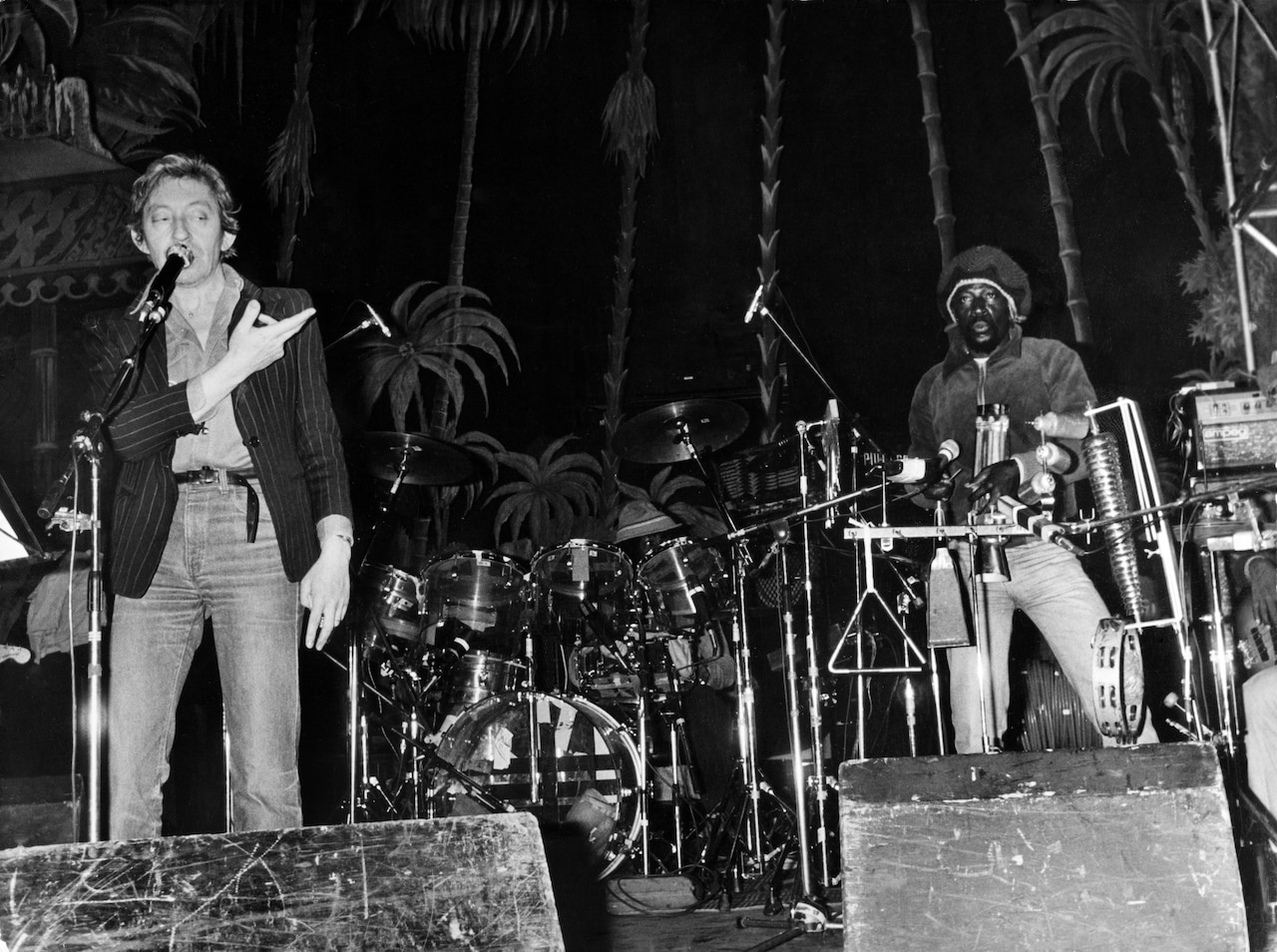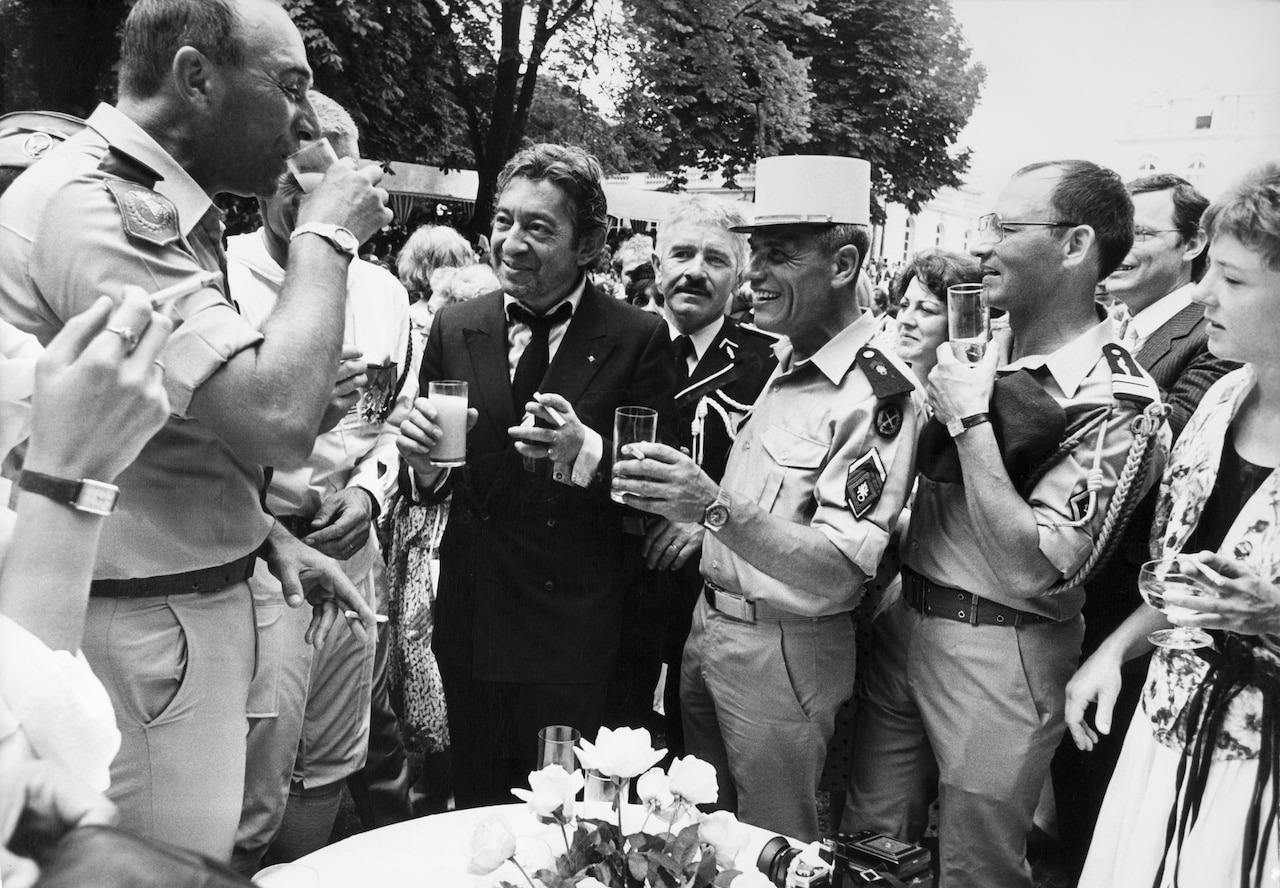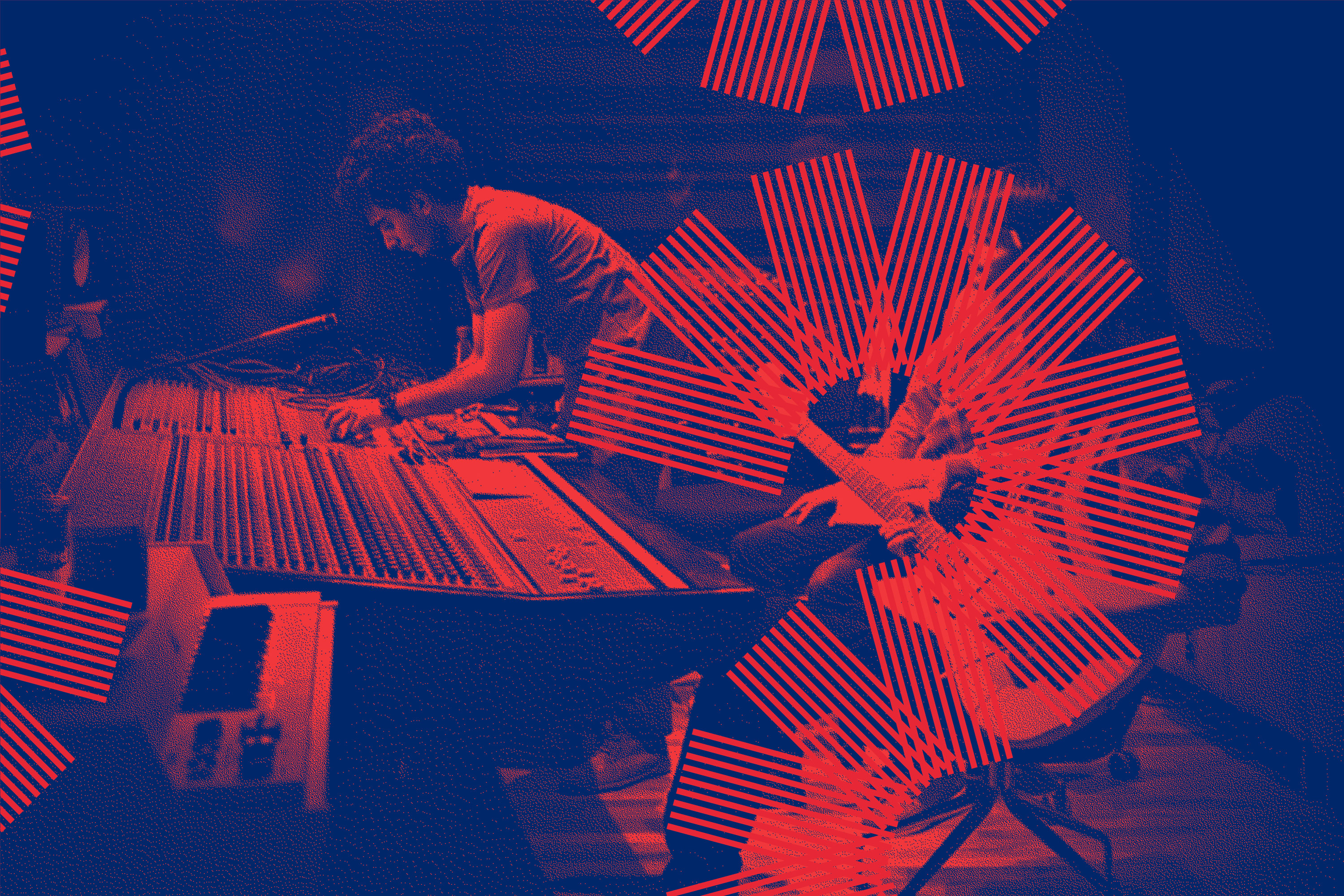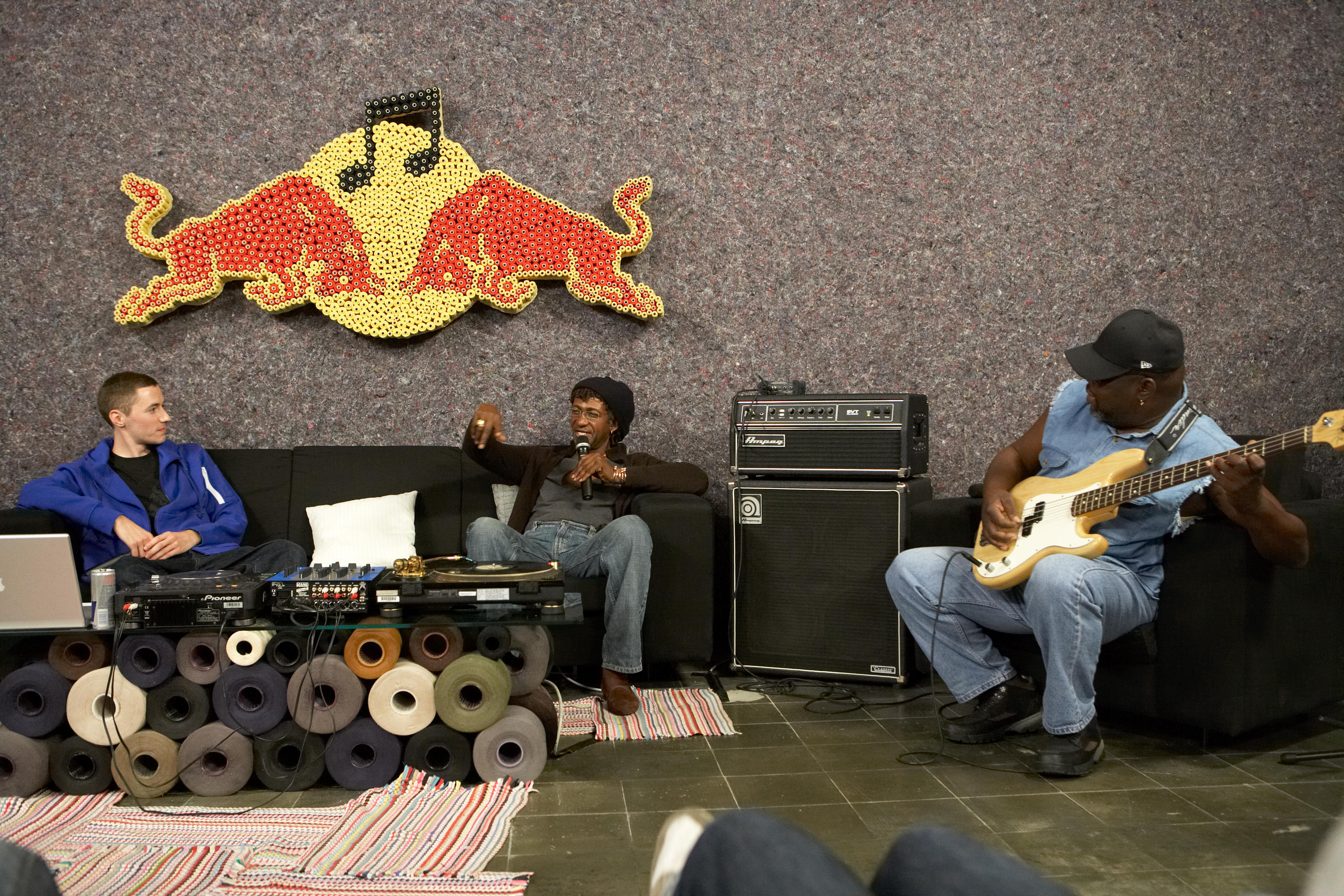Serge Gainsbourg: The Reggae Years
In a career fueled by controversy, a single song written in Jamaica was his most controversial of all. Gainsbourg biographer Sylvie Simmons explains the circumstances behind Serge’s reggae version of the French national anthem.
It had been eating at Serge Gainsbourg for quite some time – the problem of what he might do to end the ’70s with the same kind of bang as he had the ’60s. In 1969 his duet with Jane Birkin, “Je T’Aime... Moi Non Plus,” was released to scandal and huge sales. Gainsbourg was extremely fond of both, but since he wanted them on his own terms, it wasn’t easy.
The ’70s had been Gainsbourg’s Concept Album decade - starting in 1971 with the greatest of them all, Histoire De Melody Nelson. As the years progressed, the wilder his concepts became: Rock Around The Bunker, Nazi rock ‘n’ roll, and L’Homme A Tête De Chou (The Man with the Cabbage Head), a Melody Nelson-like tale of obsessive love, sex, death, madness and self-destruction, this time about a young black girl named Marilou, a shampooist in a men’s barbers shop. The protagonist follows her home, spies on her having sex with hippy rock musicians, watches her masturbating to a comic book and, when she mocks his advances, murders her, and ends up going insane. Musically, it was a mix of jagged, almost prog, rock, sumptuous, menacing orchestration, African beats and, in the song “Marilou Reggae,” reggae. The French rock press, high on punk, greeted it as a nihilistic masterpiece. It did not sell.
Gainsbourg loved good reviews, but what he wanted more was public acclaim. So, while he continued to write songs for old clientele like Francoise Hardy and Zizi Jeanmaire and new ones like Alain Chamfort, he obsessed over making a record under his own name that would put him back at the top. His experiment in bilingual disco towards the end of the ’70s (“Sea, Sex and Sun”) was not that record, nor was it the concept album (later abandoned) about a man in the back of a London taxi cab who has a heart attack and whose past flashes before him while the meter runs.
The recording studio was on a dusty street. Goats and chickens wandered about in the sun. The studio engineer was nowhere to be seen.
Then, late in the summer of 1978, Philippe Lerichomme – Gainsbourg’s producer and musical director – suggested a reggae album. “I had been asked to go to a club one Sunday night to listen to a punk band who were due onstage at midnight,” Lerichomme told me over coffee in Paris. “So I was in this half-empty club, nothing I heard had interested me, it was midnight and the punk group didn’t come on. In the meantime, the DJ was playing some very hot things – punk and reggae. That’s when it came to me, in a flash. It was two o’clock in the morning so I waited a few hours and then I phoned Serge and said, ‘We must go to Jamaica and make a reggae album.’ Serge said, ‘Good idea!’”
Lerichomme was acquainted with Chris Blackwell, founder of Island Records, who had spent his childhood in Jamaica and was responsible for introducing Bob Marley and other great reggae artists to a worldwide audience. They spoke on the phone and Blackwell suggested some reggae albums to check out; Lerichomme and Gainsbourg listened to them all. After deciding on the sound and musicians they wanted, Blackwell helped them hire Sly (Dunbar) and Robbie (Shakespeare), the renowned rhythm section, percussionist Uzziah “Sticky” Thompson and, as backing singers, the I Three, who included Bob Marley’s wife, Rita. A week was booked at Dynamic Sound Studios in Kingston – a place with the reputation of a Caribbean Muscle Shoals – and in September 1978, Gainsbourg and Lerichomme flew to Jamaica.
Then Sly said, “We know just one piece of French music. A song called ‘Je T’Aime... Moi Non Plus.’” And Serge said in English, “It’s me!”
They found the recording studio on a dusty street. Goats and chickens wandered about in the sun. The studio engineer was nowhere to be seen. Sly and Robbie were inside, but the welcome wasn’t exactly warm. Gainsbourg and Lerichomme couldn’t understand their heavy Jamaican accents and the musicians had just as much trouble with French-accented English. At first, Sly and Robbie thought Lerichomme was the artist and Gainsbourg his manager, being the older of the two and wearing a suit. “It was quite tense, no one smiling,” said Lerichomme, “and then Serge, trying to ease the atmosphere said, ‘Do you know any French music?’ And they started making fun of us, ‘French music? We’re Jamaican.’ Serge and I looked at each other, crestfallen. Then Sly said, ‘We know just one piece of French music. A song called ‘Je T’Aime... Moi Non Plus,’ which has a girl groaning in it. And Serge said in English, ‘It’s me!’ That changed the mood.”
Sly and Robbie assumed this older guy in the fancy clothes would want a polished, pretty sound, so a lot of time was spent assuring the musicians otherwise. When the band played it raw and Gainsbourg and Lerichomme applauded, things lightened up. As Sly Dunbar remembered it, “Serge just sang and we just played reggae, and he didn’t say anything. He was into the music, but he was also having a good time. He was constantly drinking, but he never looked drunk – and constantly smoking – I didn’t see him smoke ganja, it was just his French cigarettes in the blue pack. He wasn’t really singing, he was more like a poet doing French poems on top of rhythms. We didn’t know what he was singing about.”
“It wasn’t Bob Marley who initiated France in reggae,” Serge bragged in one of his swashbuckling moments, “it was me.”
That might have been for the best. “Lola Rastaquouere” was an ode to an underage Rasta girl; “Relax, Baby Be Cool” a chat-up routine against a backdrop of hooded Ku Klux Klansmen and blood running through the streets. “Eau Et Gaz A Tous Les Etages” featured a man with his penis out, pissing and farting his way up flights of stairs, while “Des Laids Des Laids” was a tribute to Gainsbourg’s dog Nana, or as he put it, “some reggae for my bitch.” “The only time he said anything,” said Dunbar, “was when we said we’ll overdub some instruments and he said, ‘No, no, no, no, no, I want it real, raw – just simple.’” At the end of the day they would all sit around the studio, listening to the playbacks, the musicians – smoking enormous spliffs – saying “Great! Brilliant!’”
Work was proceeding quickly now. In less than a week – under schedule – the album was done. Back in Paris, Serge regaled Jane with stories of having recorded in the most primitive place, with chickens clucking about on the mixing board. But he was very happy, she said, and was delighted with his reggae album. Talking with a rock journalist around this time, Gainsbourg said he loved punk and its non-conformity but he loved reggae even more – because reggae was sexual and subversive. Quite how subversive, they would find out in March 1979 with the release of the new album, Aux Armes Et Caetera.
The title was a quote from La Marseillaise, a song Serge described to Liberation newspaper as “the bloodiest song in all of history” – the French national anthem. Gainsbourg’s reggae “Marseillaise” was a masterstroke. Hearing a bunch of Rastas performing the national anthem was, for the French, like the Sex Pistols’ “God Save the Queen” and Jimi Hendrix’s “Star Spangled Banner” rolled into one big joint and smoked. “It wasn’t Bob Marley who initiated France in reggae,” Serge bragged in one of his swashbuckling moments, “it was me.”
In April ‘79, when the title track was premiered on national TV, the outcry completely dwarfed the “Je T’Aime... Moi Non Plus” scandal ten years earlier. There were death threats. Le Figaro denounced the song as an outrage, its right-wing editorialist Michel Droit questioning Gainsbourg’s nationality and accusing him of profiteering. So anti-Semitic was its tone that Gainsbourg, close to tears, wrote a long letter of response in which he described what it had been like to wear a yellow star as a Jewish boy during the Nazi invasion of Paris.
However despised he was by the nationalists and the right, he was loved by an increasingly large young audience.
Serge had never forgotten the humiliation and rejection of those years; in fact after the success of “Je T’Aime... Moi Non Plus,” the first thing he had done was award himself a medal, a platinum Star of David ordered from Cartier, as a step towards exorcising them. Rock Around the Bunker had been another step. Serge signed his letter with the name on his birth certificate – which he had changed in 1954 when he registered his first songs, because he thought it sounded like a Jewish hairdresser’s name – Lucien Ginsburg.
Bad press sells albums. Aux Armes Et Caetera was a colossal success. Not only in financial terms but musically too. By having the crème de la crème of reggae play the same dark, potent, smoky dub they would have played if there hadn’t been a middle-aged white Frenchman at the microphone, this was high-end reggae which Gainsbourg’s almost spoken style of singing fit perfectly. (Try contrasting the reggae “Javanaise Remake” with the classic 1963 original.) And, however despised he was by the nationalists and the right, he was loved by an increasingly large young audience. In the same way UK punk had embraced reggae, French punks adopted reggae Gainsbourg. At age 51, at the dawn of a new decade, Serge was officially cool.

Whether taking Aux Armes Et Caetera on the road was Gainsbourg’s idea or his record company’s isn’t known, but Gainsbourg insisted that they fly his Jamaican band over. The tour was a sell-out. The opening concert at the Palace – which they were recording for a live album – was the hottest ticket in Paris, with celebrities in the audience ranging from the expected singing stars to Rudolf Nureyev and Roland Barthes.
Outside of the capital though, things were uglier. In Strasbourg a group of retired paratroopers had been petitioning the mayor to ban the show, warning that if it went ahead they would be “obliged to intervene physically and morally with all the strength at our disposal.” Gainsbourg hired a bodyguard. There were bomb threats. Robbie Shakespeare recalled, “I didn’t sleep for days because whenever I fell asleep someone would call [my room] and say, ‘Monsieur, you have to leave the room.’” Jane, who travelled with Serge, recalled being woken in their hotel room in the early hours and ordered outside. “All the [tourist] Americans were furious to find themselves on the lawn at two in the morning with a whole lot of Rastas and Serge and me in our pajamas.”
The Strasbourg show did go on, although the sold-out crowd included a scary number of men in uniform. Birkin, standing behind a large speaker, watched with fear as Gainsbourg walked onstage alone. The band wasn’t there. Opinions differ as to why; Birkin said Gainsbourg sent them away because he didn’t want them injured on his behalf; Shakespeare said that, given all they were going through, the musicians demanded more money and he couldn’t or wouldn’t pay.
And then Gainsbourg sang, a cappella, “Aux Armes / La Marseillaise.” The paratroopers had no choice but to stand up and salute.
So it was just this one man, a white-faced little Jewish guy, under the spotlight in the middle of the stage. There were cheers and jeers. And then Gainsbourg sang, a capella, “Aux Armes / La Marseillaise,” just like any Frenchman would sing the national anthem. The paratroopers had no choice but to stand up and salute.
It was an excellent ploy – and excellent theatre. Gainsbourg ended with a French gesture of contempt – grabbing his left elbow with his right hand and throwing it above his shoulder. “I had my cuff just low enough to show them my watch,” Gainsbourg said later, a wildly expensive timepiece from Cartier, the same place he bought his platinum Jewish star. Another provocative move, it played to the “rich Jew” stereotype that Droit and Le Figaro had painted.
That show, Birkin said, along with the enormous attention Aux Armes continued to bring, caused a kind of delirium in Gainsbourg, He came home to Paris a hero, and every night he would insist on Jane going out on the town with him, parading himself in front of people and soaking up the attention and praise. Playing the tough guy took a lot of alcohol for a shy man to pull off – and this, Birkin said, was when Gainsbourg’s hard-drinking, blowhard alter-ego Gainsbarre started to appear.

In September 1981, almost three years to the date after his first meeting with Sly, Robbie and the I Threes, Gainsbourg started work on a second reggae album. Lerichomme had advised against it – “I tried to always make sure that he was en avance, never behind or following” – but Gainsbourg had the record company on his side and they wanted a repeat of the million-selling Aux Armes. So his loyal producer went with him. He was right to have felt uneasy. The studio this time – the upmarket Compass Point in the Bahamas – was nothing like laid-back Kingston, and Sly and Robbie were now big-time music businessmen. (Lerichomme remembered them walking around with copies of Billboard magazine under their arms.) Throw in Gainsbourg’s alcoholism and it made for a cold atmosphere. All Shakespeare could recall of their second reggae album with Serge was that “it felt a little bit different from the first – it’s kind of hard to explain.” Dunbar claimed to have remembered nothing about it at all.
Mauvaises Nouvelles Des Etoiles (Bad News from the Stars) had lyrics about joints, sperm, his daughter’s soiled underwear and Mickey Mouse; one of the songs was fart noises set to a reggae beat (“Evguenie Sokolov”), another claimed God as a fellow Jew (“Juif Et Dieu”) and one officially introduced the dissipated Gainsbarre character (“Ecce Homo”). Birkin, who had experienced Gainsbarre personally, had all she could take. At the dawn of the ’80s she left him for film director Jacques Doillon, the man Gainsbourg was singing about in “Vieille Canaille” (“Old Villain”) on Aux Armes.
Gainsbourg’s second reggae album was released in November 1981. There were no bomb threats, no editorials, not much of anything really. But then nothing could top Aux Armes’ newness and originality, and nothing could top the shock value and socio-political importance of a Jew leading a band of Afro-Caribbeans in the French national anthem. That same year, Gainsbourg purchased the original Rouget de Lisle manuscript of “La Marseillaise” – “It almost bankrupted me,” he said, “but it was a question of honour.”
Serge Gainsbourg: The Reggae Years on Spotify
Sylvie Simmons is the author of Serge Gainsbourg: A Fistful of Gitanes, which was recently made available digitally for the first time, with some updates.

